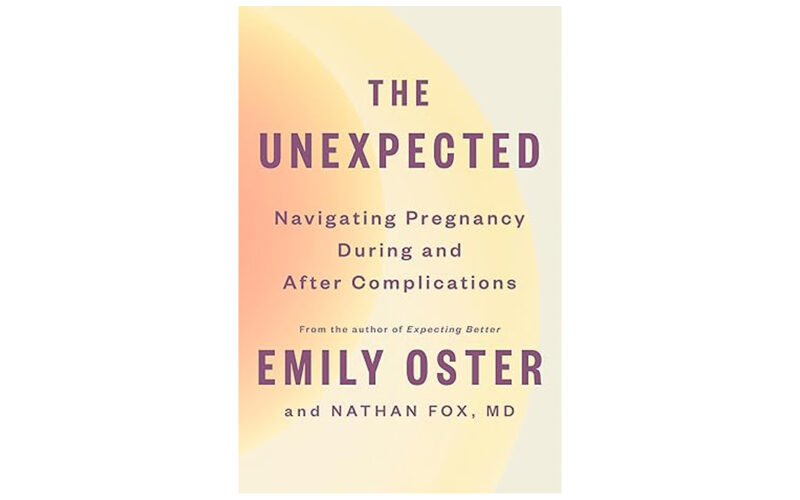Пары задают себе множество вопросов, когда задумываются о расширении семьи. Беременность и рождение еще одного ребенка часто сопряжены как с волнением, так и с тревогой. На что будет похоже появление у нашего ребенка брата или сестры? Нужна ли нам большая машина или, возможно, дом? Какой будет наша жизнь как семьи с еще одним ребенком?
Для женщин, у которых во время предыдущей беременности возникли осложнения, вопрос о повторной беременности может оказаться несколько более страшным. Будет ли эта беременность похожа на мою предыдущую? Что, если мой ребенок или я снова окажемся в опасности? Могу ли я как-то лучше подготовиться к следующему разу?
Ответы на эти непростые вопросы лежат в основе новой книги Эмили Остер, Неожиданность: Navigating Pregnancy During and After Complications. Остер провела читателей по наиболее распространенным неблагоприятным состояниям во время беременности и после родов и предоставила данные о вероятности их повторения при будущей беременности. Ее соавтор, доктор Натан Фокс, предоставляет ценную медицинскую информацию и советы. Вот наши рекомендации о том, стоит ли покупать, одалживать или пропускать эту книгу.
Эмили Остер, профессор экономики в Университете Брауна, известна своим подходом к беременности и воспитанию детей, основанным на данных. Ее книга 2013 года Ожидание лучшего стала настоящим хитом, затронув множество тем, связанных с беременностью, от употребления алкоголя до эпидуралки во время родов. Позже она написала Детская простыня и Семейная фирма о воспитании младенцев и детей школьного возраста, соответственно, и выпускает информационный бюллетень ParentData. Остер - откровенный, честный писатель, который использует свое экономическое образование для обсуждения вопросов воспитания детей.
Доктор медицины Натан Фокс, соавтор книги Неожиданность, написал короткие разделы в конце большинства глав. Он является врачом по материнско-плодовой медицине (МФМ), работающим с беременными женщинами, переживающими сложную беременность. Фокс практикует в больнице Mount Sinai в Нью-Йорке, а также ведет подкаст о беременности под названием Здоровая женщина.
Остер и Фокс - выдающиеся специалисты в своих областях, а сочетание подхода Остера, основанного на данных, и реального опыта Фокса в лечении осложнений беременности у своих пациенток создает хорошо продуманную пару.
Кто является целевой аудиторией Неожиданность?
В представлении Неожиданность, Остер объясняет, что после публикации Ожидание лучшего Бесчисленное количество женщин писали ей, чтобы узнать о своих серьезных осложнениях во время беременности. Их интересовало, можно ли и как вести будущую беременность после перенесенной гиперемезис гравидарум (ГГ), преэклампсии или даже мертворождения. Остер написала Неожиданный В качестве "дорожной карты", которая поможет этим женщинам принять важные решения во время их будущих беременностей.
Следующие состояния во время предыдущей беременности (или беременностей) рассматриваются в Неожиданность:
- Гиперемезис гравидарум (ГГ)
- Выкидыш
- Гестационный диабет (ГД)
- Преэклампсия и гестационная гипертензия
- Ограничение роста плода (FGR), также известное как внутриутробное ограничение роста (IUGR)
- Преждевременные роды
- Экстренное кесарево сечение
- Такие состояния матери, как инсульт, кровоизлияние или сепсис
- Мертворождение
- Родовые осложнения, такие как серьезные разрывы влагалища или опущение матки
- Послеродовые психические расстройства
- Препятствия для грудного вскармливания, такие как задержка лактогенеза или проблемы со снабжением
Каковы основные области содержания Неожиданность?
Неожиданный состоит из двух частей: Подготовка и Осложнения.
Подготовка
Первая часть, "Подготовка", посвящена подготовке к будущей беременности после перенесенных осложнений. Остер подробно рассказывает о том, как психологически подготовиться к новой беременности, помогает читателю сформулировать вопрос о том, стоит ли заводить еще одного ребенка, найти факты, принять окончательное решение и предпринять последующие действия.
Одним из ключевых элементов этого процесса является подготовка материалов - выбор медицинского специалиста, сбор медицинских документов и прохождение дополнительного обследования, если это необходимо. Остер объясняет, что необходимо иметь полное представление о том, что именно произошло во время вашей последней беременности, включая все документы из больницы и от врача.
После того как вы определились с выбором врача и подготовили все необходимые материалы, самое время начать задавать вопросы. Неожиданный содержит множество примеров вопросов, которые пациенты должны задавать своим врачам в зависимости от того, каким было их состояние, а также детали, которые вы должны знать заранее. Например, женщине с преэклампсией нужно обязательно узнать, когда был поставлен диагноз - до, во время или после родов, так как это может помочь понять, будет ли у нее снова преэклампсия или нет.
Осложнения
Большая часть книги посвящена второй части - осложнениям. В этом разделе Остер (при участии Фокс) подробно рассматривает каждое из перечисленных выше состояний беременности и послеродового периода. В каждой главе дается определение состояния, приводятся цитаты женщин, столкнувшихся с этим состоянием во время беременности, данные о частоте рецидивов, профилактике и лечении, а также практические рекомендации, основанные на медицинском опыте Фокс.
Например, глава о преэклампсии открывается определением и риском повторения (20-50%, что считается промежуточным). Остер разделяет различные уровни преэклампсии и приводит мнения нескольких женщин, которые столкнулись с этим состоянием во время беременности. Затем она приводит данные исследования 2016 года о приблизительном риске возникновения преэклампсии при последующей беременности, а также диаграмму, показывающую, что у некоторых женщин (особенно с тяжелой преэклампсией или HELLP до 37 недель) риск рецидива гораздо выше, чем у тех, у кого преэклампсия в полном сроке была лишь легкой. Она также взвешивает плюсы и минусы различных методов лечения, используя многочисленные исследования для подтверждения своих утверждений.
В своем разделе Фокс рассказывает о четырех наиболее распространенных рекомендациях по лечению преэклампсии (таких как прием аспирина в малых дозах и домашний контроль артериального давления) и описывает, какие типы пациенток обычно лучше всего справляются с каждой из них. Его советы доброжелательны, успокаивают и в то же время практичны.
Каковы сильные стороны Неожиданный?
Если вы пережили сложную и трудную беременность, Неожиданный может многое предложить. Она дает систему вопросов, которая будет полезна парам в их размышлениях, а также списки вопросов, которые следует рассмотреть или задать своему врачу. Советы Остера по сбору медицинской документации и пониманию того, что происходило раньше, очень важны.
В отдельных главах, посвященных каждому заболеванию, Остер, несомненно, использует свои знания. Она приводит множество исследований, которые помогают предсказать вероятность повторного возникновения тех или иных состояний, а также ценную информацию по их профилактике и лечению. Читатели также оценят рекомендации Фокс, которые дают представление о том, что может посоветовать специалист по материнско-плодовой медицине в их случае.
Еще одна сильная сторона работы Остер заключается в том, что, хотя она и предоставляет читателю основу для размышлений, подкрепленную ее исследованиями, она не дает прямых рекомендаций о том, что делать. Она дает советы о том, какие вопросы следует задать врачу и что нужно иметь в виду при рассмотрении вопроса о будущей беременности, но при этом уважает способность читателей самостоятельно принимать решения относительно вмешательства и лечения. Такой подход может придать сил, поскольку Остер предоставляет вам ресурсы, необходимые для принятия собственных решений. собственный решения, но не диктует, какими должны быть эти решения.
The Unexpected's ограничения или "слепые пятна
Самое очевидное ограничение Неожиданный в том, что в нем не обсуждается каждый осложнения беременности. Например, в нем отсутствуют такие вопросы, как внематочная беременностьстрептококк группы B (GBS) во время родов, а также редкие, но серьезные заболевания медицинские условия например, холестаз. Если вы столкнулись с какими-либо осложнениями во время беременности, перед чтением стоит ознакомиться со списком включенных в него состояний, приведенным выше (или просмотреть оглавление в книге).
Подход, основанный на данных, а не на истории
Хотя многим читателям понравится подход Остера, основанный на данных, некоторым он может показаться немного обезличенным, и они захотят получить информацию от человека, который сам "побывал там". Истории успешных родов (особенно искупительные вторые роды!) популярны не просто так, ведь многие беременные мамы хотят услышать от других женщин, как они прошли сложный путь и стали сильнее и надежнее. Неожиданный В книге есть анекдоты от женщин, но они не такие глубокие, как хотелось бы некоторым.
Раздел о кесаревом сечении
Еще одно слепое пятно Неожиданный Остер рассказывает о кесаревом сечении. Хотя Остер проделывает хорошую работу, обсуждая процесс принятия решения, который должен происходить при рассмотрении вопроса о вагинальные роды после кесарева сечения (VBAC), ее основные аргументы против повторного кесарева сечения связаны только с рисками самой операции. Она рассказывает о том, что повторное кесарево сечение может представлять риск для будущих беременностей, приводя таблицу, в которой показан риск для предлежание плаценты (когда плацента слишком глубоко внедряется в стенку матки и не отделяется самостоятельно, что может привести к необходимости проведения гистерэктомии). Все это чрезвычайно ценная информация для женщин, рассматривающих возможность проведения кесарева сечения или VBAC.
Однако Остер не вникать в тот факт, что многие кесаревы сечения в Соединенных Штатах являются в значительной степени ненужный. Она также не упоминает о том, что вагинальные роды несут в себе ряд преимущества как для матери, так и для ребенка, например, облегчение грудного вскармливания, естественное облегчение боли благодаря эндорфинам и более крепкая иммунная система новорожденного от полезных бактерий, обитающих в вагинальном канале матери.
Женщины, которые ищут информацию о кесаревом сечении и VBAC, должны дополнить ее Неожиданный с дальнейшие исследования о родах, особенно если они сомневаются в необходимости кесарева сечения в прошлом.
Вердикт: купить, одолжить или пропустить Неожиданность?
Неожиданный это отличная книга, которую можно взять в библиотеке или у друзей, если вы сталкивались с какими-либо осложнениями, о которых рассказывают Остер и Фокс. В силу характера книги обычному читателю понадобятся лишь некоторые из включенных в нее глав, поэтому нет необходимости приобретать ее в качестве справочника на будущее. Читателям будет полезно принять к сведению предложенную Остером схему принятия решений и взять информацию, включенную в главу о конкретном осложнении, с собой в медицинскую бригаду в качестве отправной точки для беседы. В целом, Неожиданный В книге содержится ценная информация для женщин, желающих родить еще одного ребенка после сложной беременности, и приводятся данные, позволяющие успокоиться и надеяться, что в следующий раз все пройдет более гладко.











